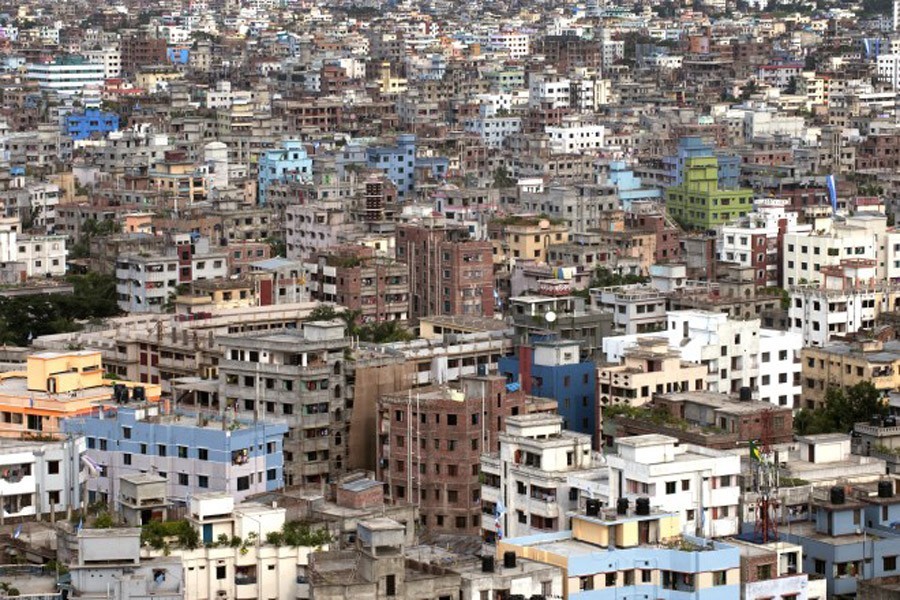
Published :
Updated :

An apathy towards and even hostility to children's outdoor activities seems to be ingrained in the social attitude of urban people. Even few people complain against a dire shortage of open space in the capital Dhaka with a population density of 23,234 per square kilometre, second highest in the world after Manila with 43,611 per square kilometre. Although the data of population density presented by different international bodies vary, one thing is clear that Dhaka remains at the top echelon of the most densely populated cities in the world. It is axiomatic that an intractably crowded city has multifarious problems beginning with a lack of decent housing to required utility services, green cover, open spaces, playgrounds for children and parks for people to be in regular touch with Nature.
The critical problem of mindless indifference to open space and playground has been highlighted at a view-exchange meeting jointly arranged by the Institute for Planning and Development (IPD) and the Work for a Better Bangladesh (WBB) Trust. With Dhaka's living condition degrading fast and earning the city the infamous laurel of 'worst liveability' among cities, the issue of living environment in this mega city has, of late, come under similar critical reviews from time to time. It emerges from deliberations at the view-exchange meeting that only 16 per cent of Dhaka's residents live within the range of sports facilities or infrastructure and the rest 84 per cent have no access to such amenities. Similar crises bedevil public health in divisional cities and district towns.
Happily, more and more people are now concerned about their and their future generations' symbiotic relations with this urban mess. The campaign headed by a woman activist for protecting the Tentultala playground in Kalabagan area from the police acquisition is a case in point. The police started construction of boundary walls of their proposed Kalabagan police station. But in the face of public protest and outrage, they had to abandon their anti-people plan.
This and a few other such positive incidents do not, however, assure environmentally conscious people of a rosy future for the city. The disturbing question, if the mega city can sustain or it will have to be abandoned never ceases to haunt them. If the extensive pollution caused by release of factory effluent, refuse such as chemical dyes, residues of burnt-up fuels from vessels and industrial chemicals from large containers into the Buriganga and other rivers around the capital continues unabated, the lifeline of the city will get snapped. Even globally, according to new research by scientists in Germany and the Netherlands, water scarcity caused by pollution of river sources could affect three billion more people than expected midway this century.
It is not only the waters of the surrounding rivers that are beyond recognition because of heavy pollution but also the city's air quality that is falling foul to make screaming headlines for the worst level of pollution in the world. Discarded plastic and polythene have been rendering both lands and water bodies increasingly contaminated. So the living condition in this chaotic city is growing insidious from all corners of the city.
The World Health Organisation stipulates that each person should have a minimum of 9.0 square metre open space such as playground, parks, gardens etcetera. This means that each 1,000 people must enjoy 2.25 acres of open space and 1.0 acre of playground. Green and open spaces should be at a walking distance. How much such spaces and facilities the city people have to breathe in is anyone's guess. If this is not enough, the manipulation of playgrounds an autocrat recovered from illegal possession to turn into child-friendly facilities in many wards of the city has rendered those unfit for games and sports. Over the past few years, those playgrounds have witnessed construction of concrete segments and walkways in some cases. Elderly people may go for morning or evening walks there but the playgrounds for children are gone.
If the all-round pollution of water and air is considered together with such shrinkage of sports facilities in the city, the extent of gross artificiality of habitation in this city becomes blatantly evident and painful. Inactive outdoor children have hardly any option other than living a sedentary life or worse becoming addicted to smart gadgets' virtual world or online video games. In the worst case scenario, the rise of a culture of teen gangsterism and the related crimes including drug abuse is a natural consequence.
City people are insanely intoxicated with immediate gains and opportunism to lose sight of the future. But sacrificing a better tomorrow for today's insane opportunism spells doom for people and places. Amid this gloom, it is heartening to know that the environment, forest and climate change ministry has taken up a 100-day programme for protection of environment from pollution. In 40 upazilas of 12 districts in coastal areas, a three-year programme has been taken for eradication of single-use plastic. More important it is to root out the source of harmful polythene and plastic once and for all.
However, this is not enough. Poisonous fume-emitting brick kilns and vehicles have to be removed, factories and industries releasing untreated effluent and refuse compelled for installation of effluent treatment plants within a reasonable time frame. Rivers, other water bodies, flood plains, green covers and urban open spaces must be recovered to health or created anew for ecological balance. Such programmes can be successful if these are complemented by decentralisation of administration as well as economic and commercial opportunities.
nilratanhalder2000@yahoo.com


 For all latest news, follow The Financial Express Google News channel.
For all latest news, follow The Financial Express Google News channel.